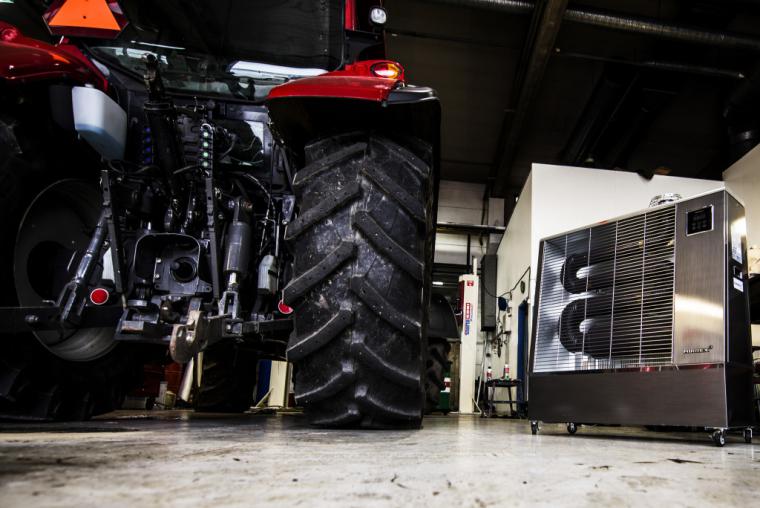
Not many enjoy the exhaust gases produced from burning diesel or fuel oil. A lot of people have found that the gases cause unpleasant symptoms in the respiratory system, mouth and throat, or even eyes, as the most sensitive people have reported.Exhaust management is not a problem for users of Airrex large space heaters that burn the fuel so efficiently that a separate exhaust outlet to the outside is not needed.
If the combustion is incomplete, the exhaust will contain various harmful compounds. Unburnt hydrocarbons, carbon monoxide, various particulates, nitrous oxide and, of course, carbon dioxide.
In case of high-quality hydrocarbon-based fuel, such as diesel, it is possible to achieve near-perfect combustion, meaning that the exhaust emissions consist mostly of carbon dioxide that is not dangerous as such, and water in the form of water vapour. Perfect combustion is the reason why Airrex infrared heaters do not require separate exhaust piping.
Kymenlaakso University of Applied Sciences (KYAMK) is one of the few institutes in Finland that perform emission measurements. Marko Piispa, leader of the emission measurement unit, recalls that the emissions from the Airrex heaters were low. He does not comment on their safety when used in sealed spaces: this can be determined by studying the guidelines and limit values set out by the authorities.
Airrex infrared heaters and exhaust gases
According to the Decree of the Ministry of Social Affairs and Health on concentrations known to be harmful (HTP) and the Ministry of the Environment procedure on carbon dioxide levels in indoor air, the maximum allowed concentration of carbon dioxide during normal weather conditions and while the room is occupied is 1,200 ppm. The acceptable exposure limit at workplaces during an 8-hour workday is 5,000 ppm.
Correspondingly, the amount of carbon monoxide in the air during an 8-hour workday should not continuously exceed 10 mg/m3. The limit for nitrogen dioxide concentration known to be harmful is 6 ppm, or 11 mg/m3, over 15 minutes of exposure.
Operating at full capacity, Airrex AH-300 produces one milligram of carbon monoxide per cubic metre of air, meaning that the recommended limit value would not be reached during 10 hours of working. As heaters rarely operate at full capacity all the time, the maximum working time is much longer. And, if normal ventilation is ensured, carbon monoxide creates no risk whatsoever.
Harmless as such, carbon dioxide is, in fact, very important for the human body. According to the emission report by KYAMK, exhaust gases from Airrex AH-300 contain 10% of carbon dioxide that is very quickly mixed with the air in the room space. This is why the carbon dioxide emissions are not considered significant.
Nitrogen oxides created when burning diesel and fuel oil are considered hazardous to health. Noteworthy in the emission measurement report of an Airrex AH-300 operating at full capacity is that the nitrogen oxide emissions with biodiesel were 201 mg/m3 while those with regular diesel were 183 mg/m3.
If exhaust gas is inhaled directly from the end of an AH-300 exhaust pipe, nitrogen oxides cause more stress on the body than recommended (6 ppm, or 11 mg/m3, 15 min of exposure), but the concentration decreases significantly when the exhaust gases mix with the air in the heated space.
As regards an Airrex AH-300 operating at full capacity, the value will remain below the concentration known to be harmful (HTP) determined by the authorities when the volume of the heated space is approximately 200 cubic metres. This translates into a room that is approximately 8 x 10 x 2.5 metres in size.
If the ventilation of the heated space is in line with the recommendations, i.e. a complete air change per every two hours, Airrex AH-300 can be used in spaces smaller than 100 cubic metres in size without risk of any health hazards due to nitrogen dioxide.
With a capacity of 13–15 kW, Airrex AH-300 warms up such a small space very quickly, after which full capacity is no longer needed. This means less nitrogen oxide emissions and, subsequently, negligible health hazards thereof.
Emissions in summary
In summary, Airrex infrared heaters do not produce dangerous amounts of carbon monoxide – and no separate exhaust piping is required. The carbon dioxide that is created is no more a health hazard than carbon dioxide normally found in the air. During initial heating in a small space, the level of nitrogen oxides created may rise to concentrations determined hazardous by the authorities.
The risk can be reduced by staying away from the (small) space during the initial heating and ensuring normal ventilation thereafter. The risk can be eliminated entirely by leading the exhaust gases outside the heated space. The smaller amount of nitrogen oxides created during the less capacity-intensive continuous heating keeps the level below the concentrations known to be hazardous.
In a nutshell: a well-designed diesel heater can achieve such perfect combustion that there is no need for a separate exhaust pipe. After reviewing the calculations, this is also confirmed by Marko Piispa, who performed the emission measurements:
“Emissions from the Airrex heater were quite low. They do not present a health risk in a large hall with appropriate ventilation.”
Visit our webstore to read more about the safe and efficient Airrex heaters .
